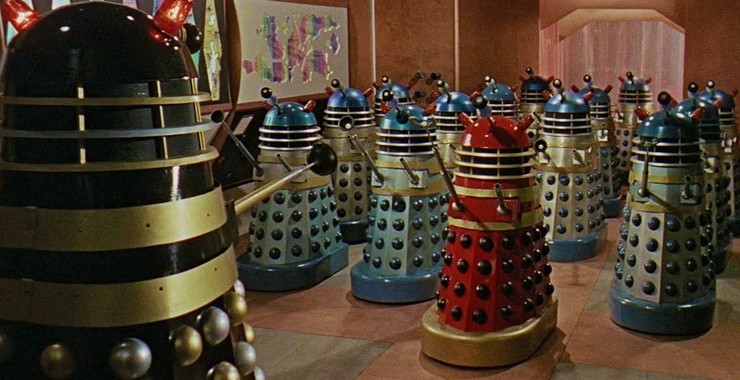Doctor Who Leaps to the Big Screen in a Pair of Technicolor Time Travelling Tales
DIRECTED BY GORDON FLEMYNG
BLU-RAY STREET DATE 09/08/20 / KINO LORBER STUDIO CLASSICS
When Doctor Who made its premiere on the BBC in 1963, no one involved in the show could possibly know that the show would become one of the longest running TV shows in history. A show that, barring a break between 1989 and 2005, is still on the air and more popular than ever. It helps keep a show going, of course, if the main protagonist is an alien known as a Time Lord, who hails from the planet Gallifrey, and who can regenerate into a completely different actor when they are killed.
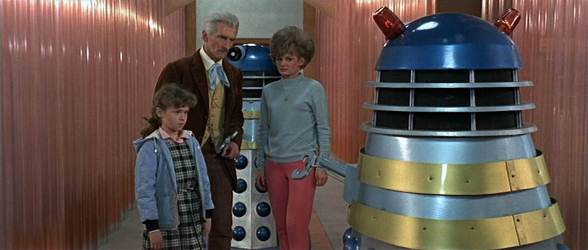
That’s at least true as the television show has presented it. On the movie screen, however, the Doctor is someone altogether different. In the early 1960’s a pair of movie producers from New York City, Milton Subotsky and Max J. Rosenberg bought the rights to produce a trio of theatrical movies based on the television show, then still in its infancy. Feeling that they needed to cast someone who was a box office draw on both sides of the Atlantic, they got Peter Cushing to play the Doctor. Cushing was best known to audiences for his appearances in the popular series of horror films from Hammer Studios, and was a natural fit for the role.
Fans of the series might be surprised to see Cushing credited as “Doctor Who” not simply “The Doctor” as he was known on the show. The movie is based on the TV show, but it’s loosely based on the show- especially the early show before a lot of the elements of what we know to be of Doctor Who are in place. The Doctor is played as a doddering and kindly old man, and he’s very much human. In one of the interview segments used in the documentary “Dalekmania” that accompanies both films, Terry Nation, creator of Dr. Who, laments that he wished Cushing’s Doctor had more of an ‘edge’ to his character. William Harntnell, who was portraying the Doctor on TV at the time was much more prickly.
Doctor Who lives in London, with his two granddaughters, Susan (Roberta Tovey) and Barbara (Jenny Linden). He invented the TARDIS. It’s still a blue police box, still bigger on the inside than on the outside, and is still a time machine. One big difference is that the interior of the TARDIS is amazingly less sophisticated than that of the TV show.
For all of these elements that are kind of the same, but different in the details, it still remains that Doctor Who and his companions travel through time and space and find themselves involved in incredible adventures. And these adventures often involve a species of alien cyborgs called the Daleks.
****
DR. WHO AND THE DALEKS (1965)
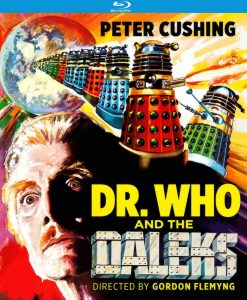
Doctor Who’s first big screen adventure was based on the second serial to air on the show, “The Daleks,” originally written by Terry Nation. Doctor Who and his companions, Susan, Barbara and Barbara’s boyfriend Ian find themselves accidentally transported to a distant planet. The planet’s surface is ruined, the soil is nothing but ash and the trees have all been petrified. What’s more is that we soon find out that the planet’s atmosphere (though happily nitrogen-oxygen based) is radioactive, and that will prove deadly for anyone breathing it in for too long a time.
It turns out that eons ago, there was a terrible nuclear war between the two dominant species on the planet: the Daleks and the Thals. Over the years, both species mutated due to the after effects of the war. The Thals are humanoid, but have grey skin, golden mop-tops, and fabulous eye makeup. The Daleks, on the other hand, have become something quite else. Though we get only a glimpse at one scaly claw, we never get a look at what, exactly, the Daleks look like. Whatever they are, the only way they can survive on the planet in their current state is to encase themselves in armored robotic shells that are equipped with a variety of grasping claws, deadly weapons, and plungers. It’s a seemingly silly design that nevertheless has become quite iconic.
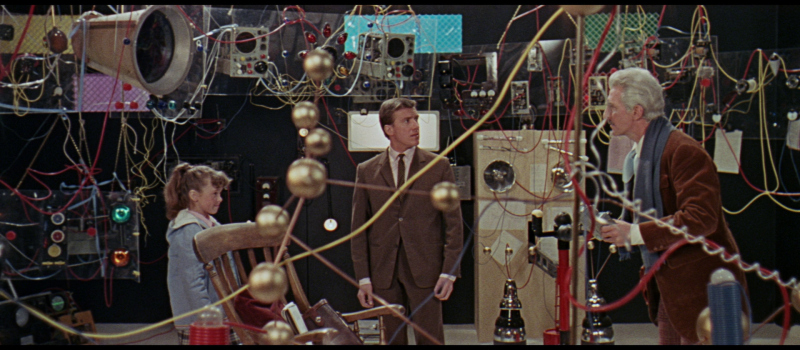
And the Daleks have never looked better. The big draw of these films for Doctor Who fans was the chance to see the adventures of their favorite time-traveller in widescreen and in color. The show was black-and-white up through 1970, so this was a big deal. And the producers made the most of it by throwing color all over the screen. The costuming and set design spare no chance to make each switch, lever, camera and control bright and vivid. The glossy metallic carapaces of the Daleks pop off the screen. The digital restoration for this blu-ray release further emphasises the colors, and delivers a crisp image.
Spending centuries as a murderous mailbox has made the Daleks a little grouchy. They capture Doctor Who and friends, and attempt to use them to lure the Thals into a deadly trap. The Earthlings have to escape, warn the Thals and discover the Dalek’s weakness so they can get back to the TARDIS and return safely to London.
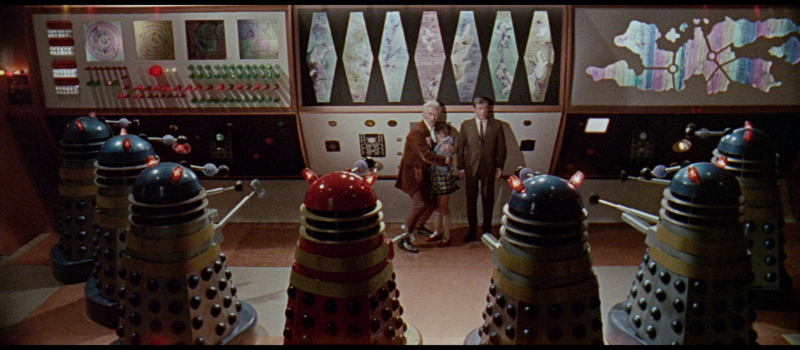
Calling the film ‘childish’ seems like too harsh a judgement. Yes, the action is tame, the morality is simplistic (and a little iffy… the Doctor pushes the pacifistic Thals into renewing their war against the Daleks). The Dalek’s plan is goofy- but the adventure is still fun if you’re willing to meet it halfway. There are some good cliffhangers that can leave an audience who engages with the show on the edge of their seat.
****
DALEKS’ INVASION EARTH 2150 A.D. (1966)
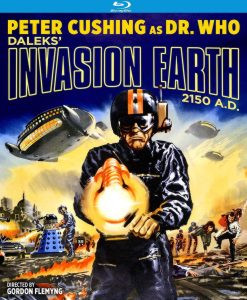
In England, Doctor Who and the Daleks did quite well at the box-office and Subotsky and Rosenberg were given an immediate green light for the sequel. Daleks’ Invasion Earth 2150 A.D. had a larger budget and a more epic storyline, also based on a series from the Doctor Who television show: “The Dalek Invasion of Earth.”
The only returning cast members (if you don’t count the Daleks) from the first film are Cushing as Doctor Who and Tovey as Susan. Tovey explains in the documentary “Dalekmania” that Cushing would only reprise his role as the Doctor if Tovey came back as Susan. The young girl was more than happy to do so.
Joining them on this adventure are the Doctor’s niece, Louise (Jill Curzon), and Tom, a police officer who stumbles into the TARDIS, played by Bernard Cribbins. Cribbins would appear in a recurring role on the relaunched series alongside the David Tennant incarnation- though it’s not the same character.
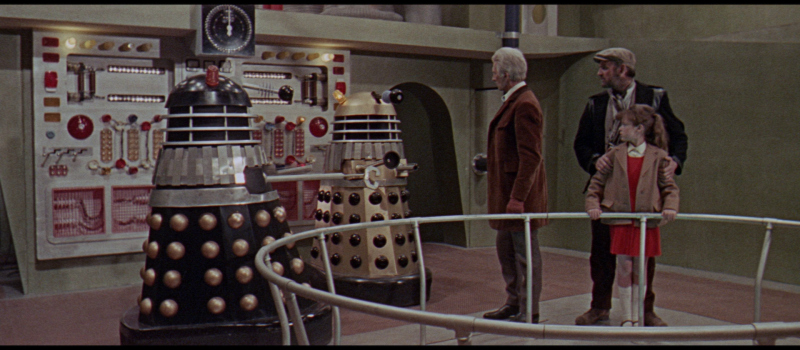
In Daleks’ Invasion Earth 2150 A.D., Tom witnesses a jewelry store robbery one night while he’s out on patrol. He dashes into the TARDIS, hoping to call in a description of the suspects (it’s a big blue police call box, remember), and is surprised to find Doctor Who, his neice, and his granddaughter who are about to visit the far-off future of 2150 A.D. They whisk Tom along with them. The group finds that the future isn’t as rosy as they were expecting. Earth (and London, specifically) is kind of a mess- and it’s because at some point in the past (err, that’s 2150’s past, but 1966’s future), Daleks have conquered the world and turned most of humanity into their slaves.
The time-travellers hook up with a band of resistance fighters to try to take back the Earth. This might seem like a daunting task for a dozen or so people from London, but remember: rebellions are built on hope!
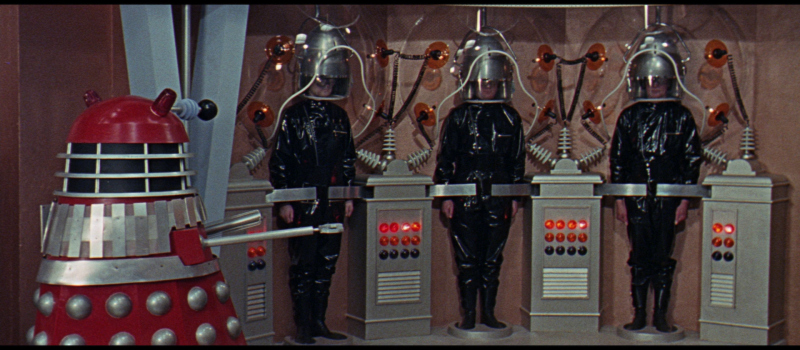
As mentioned before, this movie has a larger budget and a more epic scope than its predecessor. It’s post-apocalyptic setting is much more drab, however, and the set designs lack the color and imagination of the earlier film. Even the Dalek’s don’t look as spiffy, they’re much less vibrant. On the other hand, I guess they’ve also overcome their reliance on electricity transmitted through the floor for power (a major plot point of Dr. Who and the Daleks), and can apparently swim now.
But like the previous film, this is overall a pretty good adventure story. The science is dodgy (shocking for Doctor Who, I know) and the villainous plan (again) makes little sense, but it’s still a fun time. Cushing wears the role of the Doctor like a finely tailored suit, and Cribbins is given plenty of moments to shine- such as when he has to pretend to be a mind-controlled android, but can’t quite get in lockstep with the other members of his squad.
****

Both films come with a nice selection of special features. They each have a feature length commentary from film historian and writer Kim Newman, and Robert Shearman and Mark Gatiss, both of whom have written for the Dr. Who reboot series. Both films also have a short documentary about the digital restorations of each film. The digital transfers look gorgeous- and I wonder if the digital artists were at all tempted to digitally erase the very obvious wires on the Dalek’s spaceship in the second film (an otherwise splendid model!).
The aforementioned “Dalekmania” is the only shared feature found on both disks. It’s a 57-minute long look at the development of the Doctor’s greatest and most iconic foes, and how the two Cushing movies came to be. It included interviews with many folks involved in the productions, and featured many behind the scene photographs. A real treat for the fans.


